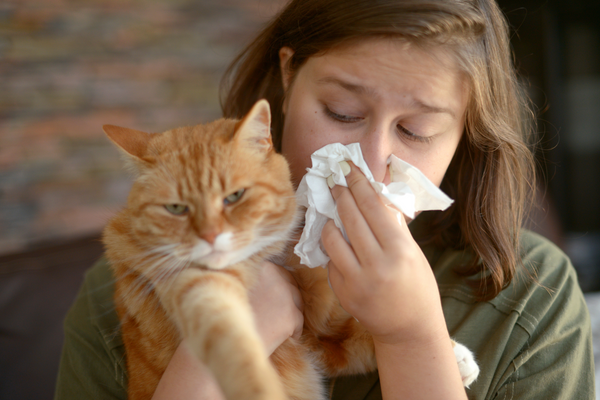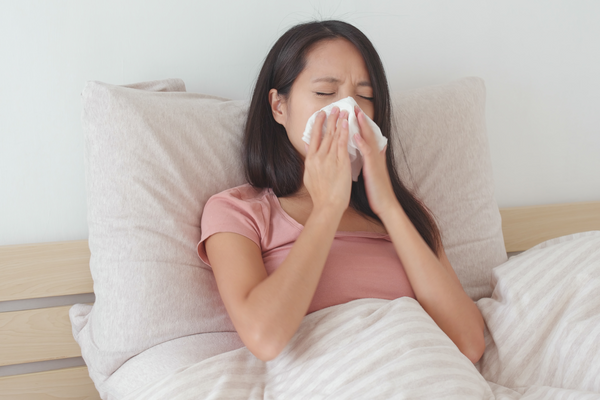The 5 Most Common Allergic Skin Conditions & Irritants

It's not uncommon to develop a rash or have skin irritation at one time or another. So how do you know when your rash is caused by an allergy or by something else? A skin rash can signal many things, but it's often the result of an allergy. Mysterious rashes send millions to the doctor each year. According to the American Academy of Allergy, Asthma & Immunology (AAAAI), skin allergies prompt approximately 5.7 million doctor visits annually.
These irritations are so common and varied that they are called by different names, which can lead to confusion. When an allergen is responsible for triggering an immune system response, the irritation is known as an allergic skin condition. In this article, we’ll go over some of the most common types of allergic skin conditions and triggers – and what you can do to help prevent them from happening.
Hives
Hives (urticaria) are pale red, itchy, raised areas of the skin that appear suddenly - either as a result of the body's reaction to certain allergens, or for unknown reasons. Hives can range in size and appear anywhere on the body. Usually, hives are known as acute and go away within a few days. According to the American College of Allergy, Asthma, & Immunology (ACAAI), about 20% of people will experience hives at some point in their lives.
As with any allergic reaction, if hives are accompanied by difficulty breathing or swallowing, this can be a sign of a much more severe and serious anaphylactic reaction. This requires immediate emergency medical attention to treat.
Angioedema
While related to hives, angioedema is swelling that affects the deeper layers of the skin. It is usually not red or itchy and often involves the eyelids, lips, tongue, hands, and feet. Angioedema commonly occurs with hives, but it can also occur on its own.
Dermatitis
An inflammation of the skin that produces a red, scaly, itchy rash is known as dermatitis. Two of the most common types are atopic dermatitis (also called eczema) and contact dermatitis.
Atopic Dermatitis (Eczema)
Eczema is a chronic skin condition that usually begins in infancy or early childhood and is often associated with food allergy, allergic rhinitis, and asthma.
Contact Dermatitis
When certain substances come into contact with your skin, they may cause a rash called contact dermatitis. There are two kinds of contact dermatitis: irritant contact dermatitis and allergic dermatitis.
Irritant contact dermatitis occurs when a substance damages the part of skin the substance comes in contact with. It’s often more painful than itchy. The longer the skin is in contact with the irritant, or the stronger the irritant is, the more severe the reaction will be. For irritant contact dermatitis, avoid the substance causing the reaction if possible. Avoiding the substance can relieve your symptoms and prevent lasting damage to your skin.
Allergic contact dermatitis is a type of delayed hypersensitivity reaction that typically occurs 48–72 hours after exposure to the allergen. It occurs predominantly from an allergen on the skin rather than from internal sources or food. To prevent the reaction from returning, avoid contact with the offending substance. If you’re unable to determine what’s causing the reaction, your doctor may conduct tests to help identify it.
Common Skin Irritants & How to Combat Them
In some cases, the trigger is obvious – a person eats peanuts or shrimp and then has an adverse reaction within a short time. Other cases require detective work because there are many possible causes. A single, acute skin reaction doesn’t usually call for extensive testing. If you suspect that you may have a food allergy, consider keeping track of what you eat. This will help you discover whether there is a link between what you’re eating and when your skin has a reaction. Chronic skin reactions should be evaluated by a doctor, who will ask about your and your family’s medical history, substances to which you are exposed at home and at work, exposure to pets, and any medications you’ve taken recently. If you have been keeping a food diary, show it to your allergist.
Here are some other common skin irritants, and methods you can use to reduce or eliminate them.
Pet Dander
According to the Asthma and Allergy Foundation of America (AAFA), allergies to pets are very common, affecting millions of Americans. An estimated 15 to 30% of people with allergies have a reaction to cats or dogs, with cat allergies being twice as common as dog allergies. Allergies to pet dander can lead to a large number of symptoms, including skin irritation, rashes, and hives. Fortunately, unless the reaction is severe, there are a number of a number of ways to reduce and eliminate allergens from pet dander without having to give up your beloved companion, including vacuuming regularly with a HEPA-type vacuum, bathing pets regularly (ideally once a week) with an Anti-Allergen Pet Shampoo to remove allergens from their fur, limiting your pet’s access to bedrooms, and using an Anti-Allergen Solution to eliminate allergens from furniture, bedding, rugs, carpeting, upholstery, and pet beds. We went over this topic in detail here.
Cosmetics & Skincare Products
A dermatology study published in 2010 found that more than a third of over 900 study participants had at least one allergic reaction to cosmetic ingredients. Cosmetics are supposed to make you look and feel good – but not if they cause a rash! So why does it happen? You may be allergic to the harsh fragrance that’s added to many beauty products. Common culprits include Amyl Cinnamal and Balsam of Peru (Myroxylon Pereirae). Unfortunately, you can’t just go with “unscented” products, since manufacturers often add chemicals to mask other smells. Instead, look for “fragrance-free” on the labels when you’re shopping for cosmetics and skincare products.
Dust Mites
Dust mites are the most common allergy and asthma triggers that lurk inside your own home. While these microscopic creatures resemble tiny bugs, dust mites don’t actually leave bites on your skin. (Note: dust mites aren’t to be confused with bed bugs, which are a separate type of species that leave visible bites on your skin.) However, an allergic reaction to these pesky creatures may induce skin rashes that are often red and itchy in nature. Allergic reactions to dust mites are common and are typically caused by inhaling the skin and fecal matter of dust mites. If you’re allergic to dust mite allergens, you’re also likely to have other allergy symptoms, such as sneezing and postnasal drip.
If you have continuous allergy symptoms throughout the year, it may be worth talking to your doctor about possible dust mite allergies. While difficult to eradicate completely, there are ways you can manage dust mite populations in your home while also treating your allergies, such as using a HEPA-type vacuum on carpeting and rugs, washing bedding at least once weekly with an Anti-Allergen Laundry Detergent to eliminate common allergens like dust mite allergens and pet dander, and deep cleaning your mattress with hot water extraction via a “rinse & vac” along with a miticide will help to keep them from coming back. Dust mites also thrive in places with high humidity, so make sure you allow plenty of time for thorough drying after deep cleaning your mattress. A fan will help speed up your drying time.
After eliminating the dust mite population, neutralize the remaining allergen with our Anti-Allergen Solution. Simply spray onto a pre-cleaned surface. This 100% biodegradable, plant-based solution contains no perfumes or dyes and is proven to denature protein allergens on contact. Use to eliminate allergens from common indoor allergens (including dust mite allergens) on bedding, pillows, pet beds, carpets, rugs, drapes, chairs, sofas, upholstered furniture, and more.
Laundry Detergent
Our skin can become extra sensitive to harsh chemicals like optical brightening agents (OBAs) as well as fragrances used to scent our laundry detergents. Clothes that are washed with harsh detergents can irritate the skin once put on. If you develop a rash where your clothing comes into contact with your skin, chances are it’s the laundry detergent you are using. Switching to an Anti-Allergen Laundry Detergent can help to eliminate uncomfortable skin rashes. Our Anti-Allergen Laundry Detergent is recommended by allergists and dermatologists and is free from harsh chemicals and fragrances. It’s powerful enough for the most demanding use, yet gentle enough for the most sensitive skin.
At The Ecology Works, all of our products are made with the well-being of people and the planet in mind. Learn more about the science behind our products, as well as great tips on disinfecting, reducing allergens, and more. If you have any questions, please feel free to Contact Us or message us on Facebook. No question is too small! We’re here to help.



